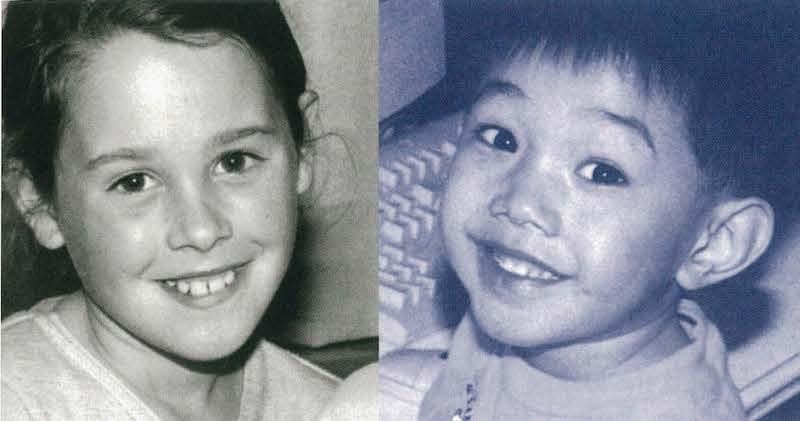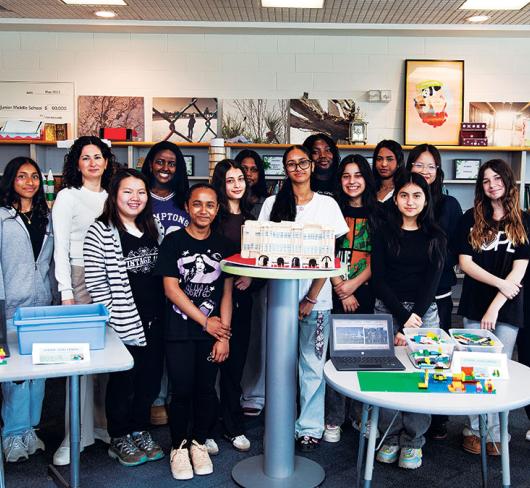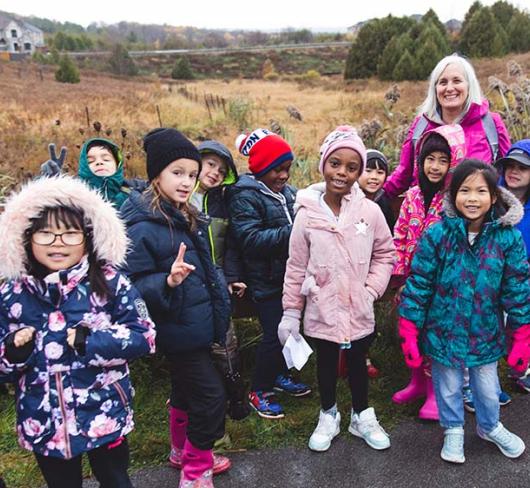
Captivated By Creativity
To most of us, the story of Alice in Wonderland conjures up visions of tardy rabbits, talking doorknobs, and crazy queens; a fanciful yarn filled with curiosity, wonder, and self discovery, where the imagination of a little girl gets the better of her. But to nearly 600 students attending General Brock Public School in Toronto, Alice is real, and so is her wonderland. As you approach Room 27, sounds of hammering, drilling, sawing, and excited chatter greet you. The sweet smell of freshly cut wood delights your nose while a scene that is hard to describe spreads out before you. Young carpenters, electricians, physicists, artisans, computer analysts, safari guides, and engineers scurry around a topsy-turvy classroom. Your eyes are drawn to a workbench where the star attraction, Alice, gathers with several of her students. Sawdust, mixed with stardust has settled at their feet, on their heads, and in their hearts.
An integrated program
But the learning isn’t limited to science. In fact, Alice Mitchell aims for total integration of the new Ontario Science and Technology curriculum. Her program extends to virtually all components of the curriculum, including numeration, the arts, literacy, and physical education, as well as enhancing essential life skills like problem solving, helping others, handling equipment and machinery safely, responsible pet care, and recycling.
Alice in the fairy tale dreamed her wonderland into existence. Alice Mitchell, a teacher for 25 years, 15 of them at General Brock, helped create this enchanted land and then disguised it in the name of science and technology.
By any other name
Don’t let the lab’s official name fool you. While the title officially justifies its existence, the children know better. Their eyes grow wide as they cross the threshold. Shy students leave their timidity at the door and journey into self-assurance. Children struggling to keep pace in the regular curriculum, blossom. Aggression evaporates. Not only are dungeons and space ships, draw bridges and doll furniture born here, but confidence, adventure, risk-taking and appreciation are nurtured as well. The heart of this wonderland is a woodworking table where every new class gathers for a review of safety rules and adventure instructions.
The lab has humble roots. It started in the back of Mitchell’s grade 4 classroom and was equipped only with a worktable, mitre, a couple of saws, and wheels and dowels. Mitchell quickly discovered that her students’ curiosity and desire for hands-on learning was hard to satisfy.
Mitchell had taught at every grade level but felt constricted in the traditional classroom setup. She longed to incorporate freedom of movement, centre- based learning, and her love for wood in her teaching. Her pint-sized makeshift world enthralled her students. But could this determined teacher captivate the entire school?
Mitchell attended a series of six workshops offered as an initiative through the former Scarborough Board of Education and applied for a $3000.00 start-up grant.
Building the program
In 1996, with the agreement of the teaching staff and support of the school’s principal, Lorraine Noble, Mitchell expanded her classroom into one corner of the staff lounge. Brock’s teachers were encouraged to bring their students in at their own initiative and with the individual teacher’s supervision. Mitchell and her class spent many hours in the staff room. The magic spread quickly and students soon found themselves tripping over each other vying for the use of the equipment. It wasn’t long before the project needed supervision and a full-sized lab. The burning question now became, where could they contain it?
With a vision and a little luck, Noble obtained a grant to build a wall, dividing the staff lounge in half, creating two rooms. One side of the room remained the lounge and the other became a new classroom. By mid 1997, a class of students had moved into the new classroom, freeing up Room 27 for the future science and technology lab.
Brock staff and students had their vision, their land, and their plan. Now they needed provisions. To supply the lab, Mitchell gathers her inventory from normal channels, like the regular school supplies order and program budgets. For additional supplies, principal and teacher rely on their ingenuity and creativity.
Noble applied for an environmental grant generously offered by Canada Trust. The monies awarded added an environmental emphasis to the room. Exotic plants and animals including a snake, lizard, hamster, and fish, flank the far side of the classroom. Working with wood naturally furthers the students’ appreciation for their world and fragile ecosystem. Mitchell continually looks for ways to draw focus to the environment.
Mining for resources
Mitchell also stockpiles bounty from unlikely sources. Treasures are discovered at garage sales and garbage day around her neighbourhood demands a slow drive by, hunting for potential. The school’s surrounding community and parents’ contributions also add to the booty. Mitchell receives a seemingly endless supply of both scrap and finished wood and cardboard from parents. Incredibly, one dedicated parent sands and prepares wood pieces on his lunch hour to donate to the classroom. When the local high school, W.A. Porter Collegiate Institute, became the Scarborough Academy of Technology, Environment, and Computer Studies, Brock didn’t hesitate to request their older computers. Noble explains it’s a matter of “working hard, being creative in your approach, selling your ideas, and using any funds you are given wisely.”
The program expands
In September 1997, Mitchell worked half time in the new science and technology lab, seeing kindergarten to grade three students while providing preparation time for teachers. The junior division still visited the room under their own teacher’s supervision. But by September 1998, Mitchell took over the lab full-time, accommodating kindergarten to grade six children, and periodically seeing the intermediates as well.
At first glance, pandemonium reigns. But closer inspection shows strong organization within the madness. Learning centres stretch out around the room, including a mini-jungle with plants and animals, a traditional art centre, computer area, Lego centre, woodworking area, and electricity and wiring centre. Children are encouraged to take advantage of at least two or more of the centres in their design. When time comes to move on, students dash about attempting to reinstate some vague resemblance to neatness, tidying the leftovers of raw imagination. The next class impatiently pushes in, moving instinctively to the workbench.
Safety first
Mitchell spends a few minutes reviewing safety rules, reminding her students about safety goggles, vise grips, and safe sawing techniques. She then presents the students’ new mission.
“Wicked!” reacts one student. Another murmurs, “Wild, look at that!”
Every child has 70 minutes each week to build his or her creation. Juniors learning about medieval times in the regular curriculum extend the strand by building replicas of turrets, gallows, siege towers, catapults, and a stake burning. Another unit involving electricity is extended when the students are asked to build a miniature model of a room in their home and arm it with working lights.
“Teachers teach the concepts and theory in class,” Mitchell explains. “Here they apply what they have learned. I’m not teaching an exact science. I’m teaching terminology, safety skills, how to use time wisely, problem solving, and how to do things with care.”
But while Mitchell’s science and technology lab may be wonderland to her students, it can be overwhelming to her.
“I see 600 students a week, and all have to be assessed,” she says. “I have to know all the kid’s names and faces.”
Mitchell periodically takes one full day to assess each child’s accomplishment, based on level of completion, uniqueness, appropriateness, lab behaviour, and time value.
Is a science and tech lab of this magnitude for every school?
“You’ve got to like it or you’ll be overwhelmed,” Mitchell explains. Noble adds, “Assessing hundreds of students is an arduous task.”
“Alice is a unique individual,” Noble says. “She is able to reach every student and drive them on to greater things. She is the champion of the underdog.”
If you would like more information about General Brock's Science and Technology program, or if you are thinking about starting your own technological wonderland, Lorraine Noble and Alice Mitchell can be reached at (416) 396-6250.
Barbara Ritson is a freelance writer who has two children attending General Brock. She is also a member of the School Advisory Council as well as a volunteer in the school's reading recovery program.

